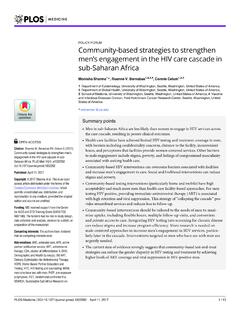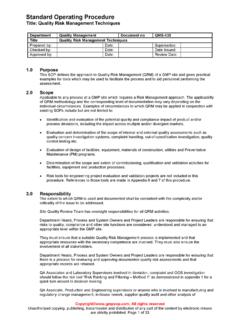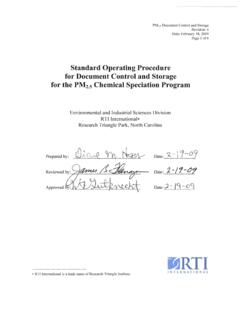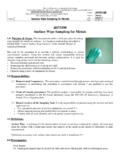Transcription of Standard Operating Procedures (SOPs) for Case Management ...
1 UNITED REPUBLIC OF TANZANIA MINISTRY OF HEALTH, COMMUNITY DEVELOPMENT, GENDER, ELDERLY AND CHILDREN Standard Operating Procedures ( sops ) for Case Management and Infection, Prevention and Control Case Management and Infection Prevention and Control Subcommittee March 2020 UNITED REPUBLIC OF TANZANIA MINISTRY OF HEALTH, COMMUNITY DEVELOPMENT, GENDER, ELDERLY AND CHILDREN SCREENING TRIAGING AND ISOLATION OF PATIENTS SUSPECTED OF COVID-19 INFECTION Screening: An area in which an individual is evaluated and screened using the case definition; if the person becomes a suspected case, refer to COVID-19 protocol. Isolation: If the case definition is met, the patient should immediately be given a mask and directed to a separate area (an isolation room if available).
2 At least 1 m distance should be kept between suspected patients and other patients. Triage: Acuity-based triage is the Standard method of sorting patients in the medical setting. This is used as the basis for identifying patients who require immediate medical intervention, patients who can safely wait, or patients who may need to be transported to a specific facility based upon their condition. A Standard , validated tool should be used to assess for severity of patients and designation to the appropriate part of the facility or the health care system (such as the Integrated Interagency Triage Tool). Triage is paramount before Management can carry on 1. Recognize and sort all patients with suspected COVID-19 at first point of contact with health care system (such as the emergency department/OPD).
3 2. Consider COVID-19 as a possible etiology of SARI Screening and triage: Screen and isolate all patients with suspected COVID-19 at the first point of contact with the health care system (such as the emergency department or outpatient department/clinic). Consider COVID-19 as a possible etiology of patients with acute respiratory illness under certain conditions (see Table 1). Triage patients using standardized triage tools and start first-line treatments. Remark 1: Although the majority of people with COVID-19 have uncomplicated or mild illness (81%), some will develop severe illness requiring oxygen therapy (14%) and approximately 5% will require intensive care unit treatment. Of those critically ill, most will require mechanical ventilation (2, 10).
4 The most common diagnosis in severe COVID-19 patients is severe pneumonia. Remark 2: Early recognition of suspected patients allows for timely initiation of appropriate IPC measures (see Table 3). Early identification of those with severe illness, such as severe pneumonia (see Table 2), allows for optimized supportive care treatments and safe, rapid referral and admission to a designated hospital ward or intensive care unit according to institutional or national protocols. Remark 3: Older patients and those with comorbidities, such as cardiovascular disease and diabetes mellitus, have increased risk of severe disease and mortality. They may present with mild symptoms but have high risk of deterioration and should be admitted to a designated unit for close monitoring.
5 Remark 4: For those with mild illness, hospitalization may not be required unless there is concern about rapid deterioration or an inability to promptly return to hospital, but isolation to contain/mitigate virus transmission should be prioritized. All patients cared for outside hospital ( at home or non-traditional settings) should be instructed to manage themselves appropriately according to local/regional public health protocols for home isolation and return to a designated COVID-19 hospital if they get worse). SCREENING FOR COVID IN ALL HEALTH FACILITIES All patients entering Health facilities should be screened for COVID-19. All facilities should put in place a mechanism for screening. Identifying appropriate area and person.
6 If the Facility is fenced, screening at the gate is more effective. National screening checklist should be used. The checklist might change depending on the evolution of the disease Health workers and individual conducting screening should practice Standard precaution, which include putting mask. FLOW CHART FOR SCREENING Standard Precautions Standard Precautions recommended measures for suspects include the following: 1. Ask the patient to wear a medical mask and move them to a single room with the door closed 2. Staff entering the room should use Standard , precautions including wearing a fit- checked P2 respiratory (or a N95) mask, disposable gown, gloves and eye protection in addition to Standard precautions. 3. Ensure that the patient, potentially contaminated areas, and waste are managed appropriately.
7 4. Cover nose and mouth during coughing or sneezing with tissue or flexed elbow for others. 5. Perform hand hygiene after contact with respiratory secretions. 6. Rational, correct, and consistent use of available PPE helps to reduce the spread of the pathogens. These precautions should continue if the patient is admitted and moved (maintaining infection control) to another hospital area. Standard Precautions for Contact and Droplet precautions for suspected COVID-19 infection: 1. Place patients in adequately ventilated single rooms 2. When single rooms are not available, can put patient in one room maintain the distanced o at least 1 meter between beds. As much as possible avoid mixing together of suspected and Conformed cases. 3. Apply Infection prevention and control measures when providing health care where COVID-19 infection is suspected, the Interim Guidance in addition to Standard Precautions, all individuals, including family members, visitors and HCWs should apply Contact and Droplet precautions is to: - Place patient beds at least 1-m apart; - Use a medical mask - Use eye/facial protection ( goggles or a face shield); - Use a clean, non-sterile, long-sleeved fluid resistant gown; - Use gloves; - Use either single use disposable equipment or dedicated equipment ( stethoscopes, blood pressure cuffs and thermometers).
8 If equipment needs to be shared among patients, clean and disinfect between each patient use ( ethyl alcohol 70%); - Refrain from touching eyes, nose or mouth with potentially contaminated hands; - Avoid the movement and transport of patients out of the room or area unless medically necessary. - Use mobile equipment as much as possible to minimize shifting of patients. eg portable X-ray. - If transport is required, use pre-determined transport routes to minimize exposures to staff, other patients and visitors and apply medical mask to patient; - Ensure that HCWs who are transporting patients wear appropriate PPE as described above and perform hand hygiene; refer to transport SOP - Notify the receiving area of necessary precautions as soon as possible before the patient s arrival; - Routinely clean and disinfect patient-contact surfaces; - Limit the number of HCWs, family members and visitors in contact with a patient with suspected COVID-19 infection; - Maintain a record of all persons entering the patient s room including all staff and visitors.
9 Prof. Mohammad Bakari Kambi Chief Medical Officer March 2020 UNITED REPUBLIC OF TANZANIA MINISTRY OF HEALTH, COMMUNITY DEVELOPMENT, GENDER, ELDERLY AND CHILDREN Standard Operating PROCEDURE FOR CLINICAL Management OF COVID 19 CASES If everything else is forgotten, remember I TIT : I T I T Identify - Test Isolate Treat Purpose and Resources The purpose of this document is to provide clinical guidance to clinicians working in Tanzania during the COVID-19 pandemic. This is the first edition of guidance on clinical Management of adult patients with confirmed or suspected infection with SARS-CoV-2, based on current WHO and AFEM (African Federation of Emergency Medicine) guidelines, knowledge and experience with urgent Management of acute respiratory distress (see below).
10 Before treating patients, it is critical to establish Procedures within each facility to protect healthcare workers, screen patients, and isolate possibly infected patients. We do not provide detail on this, but rather a high-level overview. Once a patient presents to a health care facility, they should be screened for symptoms, triaged to the appropriate part of the Emergency Department / OPD, and then triaged for severity. There is no specific antiviral treatment, thus Management is based on symptoms and respiratory status. This guide is targeted at facilities with no easy access to more advanced testing such as troponin or CT scans. Resources / additional recommendations: WHO Clinical Management of severe acute respiratory infection (SARI) when COVID-19 disease is suspected: (ncov)-infection-is-suspected Centers for Disease Control and Prevention (Atlanta, USA, particularly good advice on IPC and PPE): Emergency Care of COVID-19 In Adults in Low Resource Settings.








